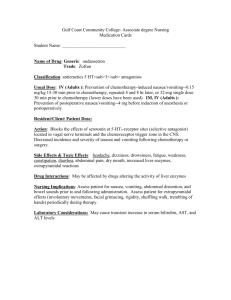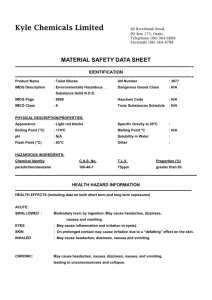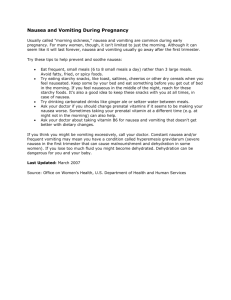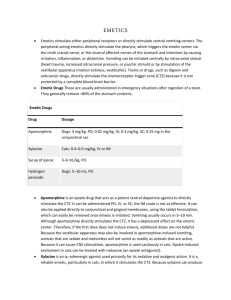Overview of nausea and vomiting
advertisement
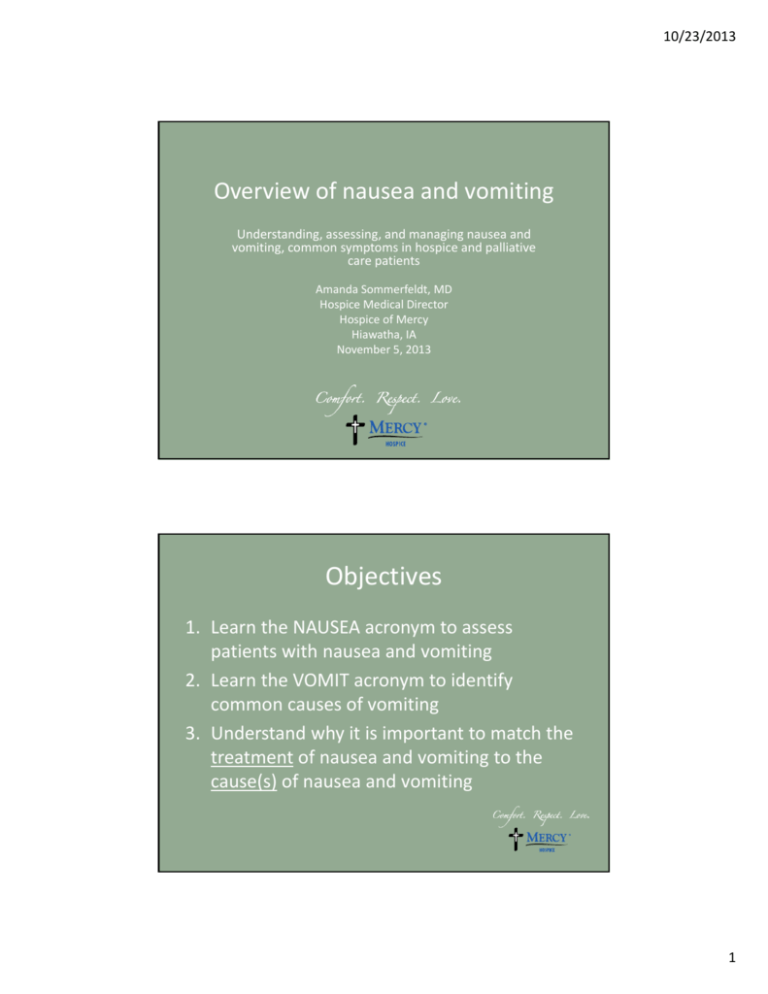
10/23/2013 Overview of nausea and vomiting Understanding, assessing, and managing nausea and vomiting, common symptoms in hospice and palliative care patients Amanda Sommerfeldt, MD Hospice Medical Director Hospice of Mercy Hiawatha, IA November 5, 2013 Objectives 1. Learn the NAUSEA acronym to assess patients with nausea and vomiting 2. Learn the VOMIT acronym to identify common causes of vomiting 3. Understand why it is important to match the treatment of nausea and vomiting to the cause(s) of nausea and vomiting 1 10/23/2013 Disclosure • Amanda Sommerfeldt, MD, has no potential or actual conflicts of interest to disclose. • Off‐label use of medications, particularly haloperidol, will be discussed during this presentation. • Subcutaneous administration of some anti‐emetic medications is done routinely in practice, but has not been well‐studied and is not recommended by the manufacturers of these medications. • Patient care is individualized. Always seek guidance from an experienced and knowledgeable physician and/or pharmacist if you have questions or concerns about medication dose, frequency, or route of administration. What is “nausea”? • Unpleasant sensation vaguely referred to the epigastrium and abdomen, with a tendency to vomit (Dorland’s Medical Dictionary) • Origin is the Greek word naus (“ship”) – Refers to the seasickness experienced by sailors – nausia in Greek, and nausea in Latin 2 10/23/2013 What does it mean to “vomit”? • To eject stomach contents through the mouth (Dorland’s Medical Dictionary) – Origin is the Latin word vomere (“spew forth”, “discharge”) • Medical term for vomit is “emesis” – From the Greek word emein (“to vomit”) Related terminology • Retching – “Dry heaves” – Same mechanism as vomiting, but glottis in back of throat stays closed, so stomach contents aren’t expelled • Regurgitation – Small amounts of food return to the mouth due to a blockage in the esophagus, an esophageal motility problem, or GERD • Rumination – Food in the stomach is returned to the mouth and then swallowed again – No nausea 3 10/23/2013 How common are nausea and vomiting? • 70‐85% of pregnant women – Usually in the first 9 weeks of pregnancy – Most severe form is hyperemesis gravidarum (up to 2% of pregnant women) • 90‐100% of patients receiving total‐body irradiation – Most common with radiation to abdomen, pelvis, or mantle – Least likely with breast, extremities, or brain • 40‐60% of patients with advanced cancer – 71% with ovarian cancer – Up to 55% still have N&V in last 4 weeks of life What’s so bad about N&V? • Diminished quality of life – Uncomfortable or distressing to patient – Upsetting to friends and family – Takes away from enjoyment of meals and can contribute to weight loss • Nausea and vomiting can be symptoms of a serious underlying problem 4 10/23/2013 Important point: Nausea and vomiting are symptoms of a diagnosis. They are not the diagnosis. Why is it so hard to treat N&V? • Patients and families don’t always report the symptoms – Some patients with cancer think that it is normal and expected to have N&V – Perception may be that it is untreatable • Failure to identify the cause of N&V – Not recognizing medications that cause or contribute to N&V – Not realizing that a patient is pregnant, has a brain tumor, is constipated, etc. 5 10/23/2013 Why is it so hard to treat N&V? • Using the wrong anti‐emetic medication – Failure to match the treatment to the cause – Using multiple anti‐emetics with similar mechanisms of action • Prochlorperazine and haloperidol • Granisetron and ondansetron – Failure to recognize that the cause of N&V can change over time • Cancer patient who had chemo in the past now has N&V due to constipation Why is it so hard to treat N&V? • Wrong dose – Not giving the anti‐emetic medication often enough – Not increasing the doses of anti‐emetic medications when appropriate • Inappropriate route of administration – Giving oral meds to someone who can’t swallow or who is continuously vomiting – Giving rectal meds to someone with frequent diarrhea 6 10/23/2013 How to successfully manage nausea and vomiting (in 3 easy steps) 1. Assess the patient • • History Physical examination 2. Identify the cause(s) of the N&V, if possible 3. Direct treatment toward the cause • • • Fix the cause when possible Medications Non‐pharmacologic measures Step 1: Assessment of nausea and vomiting Remember N‐A‐U‐S‐E‐A 7 10/23/2013 Assessment of N&V • Nausea history and intensity Rating on 0‐10 intensity scale Description and duration of symptoms Previous experiences with nausea and vomiting • Aggravating factors Certain foods, eating, drinking, not eating, medications, movement, time of day • QUality of life How upsetting is this? Assessment of N&V • Symptoms associated with the nausea/vomiting Dizziness, fatigue, sweating, pain, constipation, diarrhea, fever, weight loss, anxiety, depression, etc. • Emetic episodes per 24 hour period • Alleviating factors What helps? Medications, distraction, food, vomiting 8 10/23/2013 Examining the patient with N&V • Appearance – Sick or well? – Distressed or calm? – Pale? Jaundiced? • Skin and mucous membranes – Sweaty, excess salivation – Can see skin tenting and dry mouth with dehydration Examining the patient with N&V • Abdominal exam – Tenderness – Distention – Fluid wave to suggest ascites – Masses – tumor, stool, bladder – Bowel sounds • May need a rectal exam if constipated 9 10/23/2013 Step 2: Identify the cause(s) of the nausea and vomiting Remember V‐O‐M‐I‐T The major players 1. GI tract 2. Vestibular apparatus • Part of the inner ear that senses motion and body position 3. Chemoreceptor Trigger Zone (CTZ) Area postrema on the floor of the 4th ventricle Located in the dorsal medulla (brainstem) Loose blood‐brain barrier • • • • Chemicals in the bloodstream and CSF can affect the CTZ 4. Cerebral cortex • Taste, sight, smell, memory, and emotion can stimulate or suppress nausea and vomiting 10 10/23/2013 What makes a person vomit? GI tract Vestibular apparatus CTZ Cerebral cortex Emetic Center nucleus tractus solitarius in the medulla Receptors involved CTZ GI tract D2, 5‐HT3, also M1, H1, NK1 5‐HT3, also M1, H1, NK1 Vestibular apparatus H1, M1 Emetic Center Cerebral cortex M1 11 10/23/2013 Nausea and vomiting occur when the GI tract, CTZ, cerebral cortex, and/or vestibular apparatus signal the Emetic Center to trigger vomiting V ‐ Vestibular • Motion sickness, BPPV, Meniere’s disease, tumor, infection affecting inner ear (labyrinth) • Visual cues can also trigger nausea Stimulation of inner ear or direct visual stimulus Release of ACh, histamine Stimulation of vestibular nuclei in the brainstem Activation of the Emetic Center Emesis 12 10/23/2013 O – Obstruction of bowel • Constipation, ileus (slowed bowel), partial or complete bowel obstruction • Think of a clogged water pipe Blocked intestinal flow Dilation of bowel before the blockage and decompression of bowel past the blockage Increases in bowel lumen pressure, bowel wall edema, fluid secretion, and peristalsis Release of ACh, histamine, +/serotonin Activation of the Emetic Center Emesis M – Motility problems in the upper gut • Medical conditions – Diabetes, AIDS, scleroderma, small cell lung cancer, cirrhosis, pancreatic cancer, gastroenteritis, GERD, hypo/hyperthyroidism, neurologic disorders (CVA, ALS, Parkinson’s) • Psychiatric disorders and rumination syndrome • Medications like opioids, lithium, nicotine, CCBs, clonidine, TCAs, some chemotherapies • Iatrogenic – Radiation, injury to vagus nerve during surgery 13 10/23/2013 M‐ Motility problems in the upper gut Medical condition, medication, or injury to vagus nerve Interruption of electrical and/or mechanical processes that regulate stomach contractions Release of dopamine, serotonin, histamine, ACh, +/substance P Activation of the CTZ, or direct activation of the Emetic Center Emesis I – Infection/Inflammation • Bacterial toxins, viral infections, meningitis, encephalitis • Brain tumor, concussion, stroke Infection or Inflammation Release of dopamine, serotonin, NE, enkephalins, GABA, +/substance P Activation of the CTZ Activation of the Emetic Center Emesis 14 10/23/2013 T ‐ Toxins • Metabolic disorders – DKA, uremia, low oxygen, elevated calcium – Estrogen release of pregnancy • Drugs – Sinemet, estrogen, opioids (D2 mediated), chemotherapy, digoxin, nicotine, general anesthetics, ergot alkaloids Toxin Release of dopamine +/serotonin Activation of the CTZ Activation of the Emetic Center Emesis Step 3: Direct treatment toward the cause of the N&V Fix when possible. Palliate when fix is not possible or not feasible. 15 10/23/2013 General management principles • Treat the underlying cause if possible • If constipated, consider benefits and burdens of a laxative regimen – Senna acts by stimulating the myenteric plexus in the GI tract • Some anti‐emetic medications can be used to treat other symptoms as well – Agitation – Anxiety – Secretions General management principles • May need more than one medication – Avoid using multiple medications with similar mechanisms of action • Limited data to support the efficacy of the medications used – Case reports – Small studies • Usually cancer patients receiving chemotherapy 16 10/23/2013 Classes of anti‐emetic medications 1. 2. 3. 4. 5. Anticholinergic (acetylcholine blockers) Anti‐dopaminergic (dopamine blockers) 5‐HT3 antagonists (serotonin blockers) Antihistamines (histamine blockers) Other – – – – Corticosteroids Cannabinoids Benzodiazepines Novel drugs Anticholinergics • Mechanism of action – Block acetylcholine (ACh) at muscarinic (M1) receptors • Drugs – Scopolamine patch – TD – Hyoscyamine – SL, PO – Meclizine (Antivert) – PO • Also acts as an antihistamine 17 10/23/2013 Anticholinergics • Useful for – Vestibular N&V • Motion sickness • Room‐spinning dizziness, inner ear problems • Side effects and risks – Sedation or confusion, especially in elderly or very ill – Dry mouth, blurred vision, tachycardia, dizziness, flushing, urinary retention Anti‐dopaminergics • Mechanism of action – Block dopamine at D2 receptors – Metoclopramide also acts as a pro‐kinetic • 3 classes of drugs • Useful for – N&V due to opioids, electrolyte imbalances, migraine, CTZ activation, or unknown cause – Dual purpose if patient also has agitation, delirium, or psychosis – Metoclopramide specifically for upper GI motility disorders 18 10/23/2013 Classes of dopamine blockers 1. Phenothiazines • • • Prochlorperazine (Compazine) – PO, PR, IV Chlorpromazine (Thorazine) – PO, IV, IM Perphenazine (Trilafon) – PO 2. Butyrophenones • Haloperidol (Haldol) – PO, IV, IM, SC • Droperidol (Inapsine) – IM/IV only 3. Substituted benzamide • Metoclopramide (Reglan) – PO, IV Risks and side effects of dopamine blockers • Common side effects – Sedation, dizziness, dry mouth – Haloperidol is less sedating • Rare, more serious side effects – Extrapyramidal symptoms • Tremor, movement disorders – Tardive dyskinesia • Repetitive, involuntary movements like lip smacking – QT prolongation / arrhythmia • Associated with haloperidol and droperidol • Continuous EKG recommended with droperidol 19 10/23/2013 Contraindications to using dopamine blockers • Parkinson’s disease and related conditions – Increased risk of dopamine depletion leading to EPS or tardive dyskinesia • Movement disorders • Caution if prolonged QT, heart disease, history of arrhythmia, dementia, elderly, history of seizures 5‐HT3 antagonists • Mechanism of action – Block serotonin at 5‐HT3 receptors • Drugs – Ondansetron (Zofran) – PO, IV – Granisetron (Kytril, Sancuso) – PO, IV, TD – Dolasetron (Anzemet) – PO, IV • Useful for – Most data for chemotherapy‐induced N&V – Prevent post‐op emesis or emesis from radiation – Can use for N&V due to opioids and some other toxins 20 10/23/2013 Serotonin blockers • Side effects and risks – Headache, dizziness, itching, urinary retention, constipation, diarrhea – Elevated liver enzymes – Extrapyramidal symptoms (EPS) – rare – QT prolongation (rare) Antihistamines • Mechanism of action – Block histamine at H1 receptors – Many also block acetylcholine (anticholinergic) • Drugs – Promethazine (Phenergan) – PO, PR, IV, IM – Dimenhydrinate (Dramamine) – PO, IV – Diphenhydramine (Benadryl) – PO, IV Newer antihistamines like loratadine (Claritin) and fexofenadine (Allegra) do not cross the BBB and are not useful treatments for N&V 21 10/23/2013 Histamine blockers • Useful for – Vestibular N&V – Patients who also have nasal allergies, congestion, URI, or insomnia • Side effects and risks – Sedation, blurred vision, dizziness, dry mouth, urinary retention, confusion (especially elderly) – Extravasation risk (IV > IM) Other anti‐emetic medications 22 10/23/2013 Corticosteroids • Mechanism of action – Unclear – May block release of arachidonic acid • Drugs – Dexamethasone (Decadron) – PO, IV, IM – Methylprednisolone (Medrol) – PO, IV, IM • Useful for – N&V due to inflammation, chemotherapy, unknown cause – Patients who also have anorexia or fatigue • Side effects and risks – Fluid retention/edema, insomnia, agitation, psychosis, adrenal insufficiency, hyperglycemia, immunosuppression, bone loss Cannabinoids • Mechanism of action – Affect cannabinoid receptors near the Emetic Center • Drugs – Dronabinol (Marinol) – PO • Useful for – Advanced HIV/AIDS – Better tolerated and works better for younger patients or patients who previously benefited from Marinol or marijuana • Side effects and risks – Sedation, dizziness, agitation, hallucinations, seizures 23 10/23/2013 Benzodiazepines • Mechanism of action – Enhances the effects of GABA by binding to benzodiazepine receptors in the brain • Drugs – Lorazepam (Ativan) – PO, IV, IM, SC • Useful for – Anticipatory or vestibular N&V – Associated anxiety or insomnia • Side effects and risks – Sedation, dry mouth, dizziness, paradoxical agitation, abuse, dependence Novel anti‐emetics • Aprepitant (Emend) – Blocks Substance P at NK‐1 receptors – Used with dexamethasone and serotonin blockers to prevent delayed CINV – Very expensive! • Olanzapine (Zyprexa) – Atypical antipsychotic that blocks dopamine, serotonin, and histamine – Used for N&V caused by opioids or CINV – Also used for refractory N&V in advanced cancer – More expensive and sedating compared with haloperidol 24 10/23/2013 Cost considerations Haloperidol 1 mg $20 for #90 Prochlorperazine 5 mg $14 for #30 Metoclopramide 10 mg $17 for #90 Ondansetron 8 mg $40 for #30 Scopolamine 1.5 mg patch $69 for #4 Dronabinol 5 mg $679.93 for #60 What do I do if I have no idea what is causing the nausea and vomiting? Think safety, efficacy, and cost‐ effectiveness 25 10/23/2013 Treatment recommendations when cause of N&V is not known • • • • Haloperidol Prochlorperazine Metoclopramide Dexamethasone Non pharmacologic measures • Mainly anecdotal evidence • Ask and educate – Uncover hidden fears about what the N&V means – Many patients assume it is normal to not move bowels if patient is not eating (it’s not!) – Review what is possible in terms of N&V management – Review diet • Might try small, more frequent meals • Low fat diet and avoidance of non‐digestible fiber if early satiety or delayed gastric emptying 26 10/23/2013 Non‐pharmacologic measures • Ginger – May help nausea/vomiting in early pregnancy or motion sickness – Animal studies show benefit for CINV • Acupuncture – Some efficacy for treating CINV and post‐op N&V • Cognitive behavioral therapies (CBT) – May help prevent cortical N&V Non‐pharmacologic measures • Progressive muscle relaxation and guided imagery may help prevent CINV • Hypnosis – May help reduce N&V, early satiety, and anxiety – To work, patient must be able to concentrate • Other measures tried – Distraction – Systematic desensitization – Music therapy 27 10/23/2013 Conclusions 1. Nausea and vomiting are common symptoms that are associated with a variety of medical conditions. 2. N&V can adversely impact quality of life in a number of ways. 3. The NAUSEA acronym can be used to aid in the assessment of patients with N&V. Conclusions 4. The VOMIT acronym can be used to quickly recall common causes of N&V. 5. Management of nausea and vomiting is most likely to succeed when the treatment is matched to the cause. 6. Haloperidol is a cost‐effective medication that can be used to manage N&V due to a variety of causes, but it is not appropriate for all patients or in all circumstances. 28 10/23/2013 References / Further Reading 1. Abrahm JL and Fowler B. “Chapter 169: Nausea, vomiting, and early satiety”. Palliative Medicine. Declan Walsh, Ed. P921‐ 931. Saunders. 2009. 2. Bruera E, Belzile M, Neumann C, Harsanyi Z, Babul N, Darke A. A double‐blind, crossover study of controlled release metoclopramide and placebo for the chronic nausea and dyspepsia of advanced cancer. J of Pain and Symptom Management, 19(6): 427‐435. June, 2000. 3. Camilleri M. “Pathogenesis of delayed gastric emptying”. UpToDate. Most recent update 7/18/10. http://www.uptodate.com 4. Critchley P, Plach N, Grantham M, Marshall D, Taniguchi A, Latimer E, Jadad AR. Efficacy of Haloperidol in the treatment of nausea and vomiting in the palliative patient: a systematic review. J of Pain and Symptom Management, 22(2): 631‐634. Aug, 2001. 5. Davis MP and Hallerberg G. A systematic review of the treatment of nausea and/or vomiting in cancer unrelated to chemotherapy or radiation. J of Pain and Symptom Management, 39(4): 756‐767. April, 2010. 6. Hain TC. “Emesis”. Most recent update 10/21/01. http://www.tchain.com/otoneurology/treatment/emesis.html 7. Hallenbeck J. “Fast Fact #5: The causes of nausea and vomiting (VOMIT), 2nd Ed”. Re‐edited 3/09. http://www.eperc.mcw.edu 8. Hallenbeck JL. “Chapter 5: Non‐pain symptom management: Nausea and vomiting: Overview”. Palliative Care Perspectives. Oxford University Press, Inc. 2003. 9. Hardy JR, O’Shea A, White C, Gilshenan K, Welch L, Douglas C. The efficacy of Haloperidol in the management of nausea and vomiting in patients with cancer. J of Pain and Symptom Management, 40(1): 111‐116. July, 2010. 10. LeGrand SB and Walsh D. Scopolamine for cancer‐related nausea and vomiting. J of Pain and Symptom Management, 40(1): 136‐141. July, 2010. References / Further Reading 11. Longstreth GF and Hesketh PJ. “Characteristics of anti‐emetic drugs”. UpToDate. Most recent update 4/18/11. http://www.uptodate.com 12. Kuver R, Sheffield JV, McDonald GB. “Nausea and vomiting in adolescents and adults”. University of WA School of Medicine CME. Accessed 8/12/11. http://www.uwgi.org/guidelines/ch_01/ch01txt.htm 13. Pan CX, Morrison S, Ness J, Fugh‐Berman A, Leipzig RM. Complementary and alternative medicine in the management of pain, dyspnea, and nausea and vomiting near the end of life: a systematic review. J of Pain and Symptom Management, 20(5): 374‐387. Nov 2000. 14. Tucker RO and Nichols AC. “Managing nonpain symptoms”. UNIPAC 4, 4th edition. C. Porter Storey, Jr, ed. American Academy of Hospice and Palliative Medicine. 2012. 15. Weissman DE. “Fast Fact #25: Opioids and nausea, 2nd Ed. Re‐edited 3/09. http://www.eperc.mcw.edu 16. “Idiopathic gastroparesis”. Johns Hopkins Medicine Gastroenterology and Hepatology website. Accessed 8/15/11. http://www.hopkins‐gi.org/GDL_Disease.aspx?CurrentUDV=31&GDL_Cat_ID=83F0F583‐EF5A‐4A24‐A2AF‐ 0392A3900F1D&GDL_Disease_ID=DBFA1F93‐0401‐48C3‐A6E0‐8A0BEDD710AD 17. Word etymology courtesy of the Online Medical Dictionary. Accessed 8/15/11. http://www.etymonline.com/ 18. Medical definitions courtesy of Dorland’s Online Medical Dictionary via TheFreeDictionary by Farlex. Accessed 8/15/11. http://medical‐dictionary.thefreedictionary.com/ 19. Drug pricing courtesy of Epocrates software. Accessed 10/16/13. 29 10/23/2013 Thank you! Questions? Comments? Concerns? 30

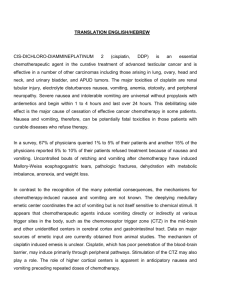
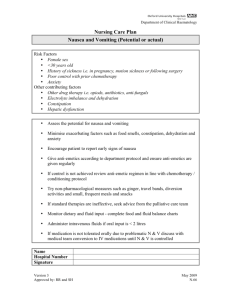
![[Physician Letterhead] [Select Today`s Date] . [Name of Health](http://s3.studylib.net/store/data/006995683_1-fc7d457c4956a00b3a5595efa89b67b0-300x300.png)
